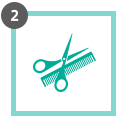Hair Mineral Analysis Test
What Is a Hair Mineral Analysis Test?
The hair mineral analysis test is a reliable tool to screen the dynamics of minerals, meaning essential mineral excesses or deficiencies and toxic mineral accumulation, in your body. The test examines the levels of mineral elements incorporated in hair and uses statistical methods to analyze them.
Toxic minerals in particular, such as mercury, arsenic, lead, cadmium, or aluminum, cause toxicity even in small amounts. In blood tests, it is difficult to accurately calculate the levels of toxic minerals due to their low concentrations and high variability. However, because toxic minerals are more highly concentrated in hair than in blood, the hair mineral analysis test can readily measure them. Hair also plays the role of an “excretory tissue for minerals.” The major benefit of this test is that, unlike blood tests, it is non-invasive, and even children may take it without worry.
 What a Hair Mineral Analysis Test Will Tell You
What a Hair Mineral Analysis Test Will Tell You

*Along with your test results, we will send you a document summarizing important dietary points recommended by the Kyorin Preventive Medicine Institute. Please make use of this to review and improve your dietary habits.
●Excess, deficiency, or the balance of essential minerals in your body
●Amount of toxic minerals in your body (mercury, arsenic, lead, cadmium, etc.)
●Nutrition programs to prevent diseases
| Essential Minerals (12 types) These minerals are components of a living organism and play essential roles in physiological functions. |
Sodium, Potassium, Magnesium, Calcium, Phosphorus, Selenium, Chromium, Molybdenum, Manganese, Iron, Copper, Zinc |
|---|---|
| Toxic Metals (5 types) These metals may negatively affect health and are not considered essential. |
Cadmium, Mercury, Lead, Arsenic, Aluminum |
| Potentially Toxic Metals (3 types) The minerals in the contaminated substances associated with cross-border air pollution, such as PM 2.5, may negatively affect health and have the potential to be identified as toxic in the future. (PM stands for particulate matter, also called particle pollution, and is the term for particles found in the air.) |
Strontium, Antimony, Barium |
| Possibly Essential Minerals (3 types) These minerals have not yet been specified as “essential,” and their existence has been confirmed only in higher animals. |
Vanadium, Cobalt, Nickel |
| Other Minerals (6 types) | Niobium, Palladium, Neodymium, Tungsten, Thallium, Platinum (Pt) |
*Kyorin Preventive Medicine Institute partners with La Belle Vie Laboratory Inc., a Japanese institute, to perform hair mineral analysis tests.
 Who Should Take This Test?
Who Should Take This Test?
●Children who are picky eaters.
●Those with a risk of passive smoking
●Children who demonstrate behaviors such as unstable temper, hyperactivity, lack of attention, autistic tendencies, etc
●Those suffering from atopic dermatitis or allergies
●Those interested in monitoring the effects of supplements
●Those wishing to identify supplementation needs
●Women who are pregnant or considering pregnancy
●Those who are too busy to have a medical checkup
●Those interested in improving their appearance by eliminating toxins from the body
●Those who feel tired, stressed, and somewhat unwell
●Those interested in anti-aging (aging prevention)
●Those wishing to prevent lifestyle-related diseases (e.g., obesity, diabetes, hypertension)
An Explainer Video to Learn What the Test Is
*Please note that this video is all in Japanese.
 How to Obtain the Hair Mineral Analysis Test
How to Obtain the Hair Mineral Analysis Test
-

Please apply using the dedicated form. Once we receive your application, we will send you an email detailing the credit card payment process. After your payment is confirmed, we will mail the test kit to you.
-

Please snip a small hair sample (0.1 gram of hair), following the enclosed instructions.
-

Ship the sample and enclosed questionnaire to a laboratory to be analyzed.
*The sample will be sent to the laboratory directly, not to Kyorin Preventive Medicine Institute. -

The test results will arrive in about two weeks within Japan. For overseas, please check and confirm separately.
 Test Payment/How to Order
Test Payment/How to Order
One test kit: 11,000 yen (tax, shipping fees, and test fee included)
If you would like to take Hair Mineral Analysis Test, please contact us with this form.
Please note:
• This test is conducted entirely in Japanese, including the application procedure and communication of test results.
• This test employs systems generally (but not exclusively) designed for and aimed at people living in Japan, including shipping systems to send the test kits and return specimens.
Frequently Asked Questions
- Is there an age restriction to take this test?
-
The test is available to people of all ages.
- How much hair does the test require, and of what length?
The required amount is 0.1 g, about 50 strands, of hair. You should cut a sample about 3 cm, or 1.2 inches, from the scalp (or pull it up from the roots). As long as the hair provided meets the required amount, the test can examine the hair shorter than the required length. If your hair is longer than the requirement, make sure to collect hair close to the root, rather than the end. The amount of hair is more important than the length. If the weight amount is too low, new samples will need to be collected. Please refer to the instructions enclosed in the test kit.
- Why does the sample have to be cut from the roots and not the ends of hair?
Hair grows an average of about one centimeter a month. The mineral information contained in the ends of long hair may be quite old, making it impossible to determine the most recent mineral dynamics. Additionally, long hair is more likely to be damaged from brushing or heat styling, and the metals contained in hair products can easily penetrate damaged hair. Therefore, those metals may affect the values of test results.
- Can dyed hair be used as a sample for this test? What about bleached or permed hair?
All of them can be tested. The enclosed questionnaire has items to be checked: coloring, bleached, and permanent wave. However, you may want to avoid cutting the hair sample until two weeks after these procedures because they may strongly affect the results. If you perform those procedures at home using commercial products, please write the product name in the questionnaire’s margin.
- Can gray hair be used as a sample for this test? Will the test results come out differently compared to black hair samples?
Gray hair is not a problem for this test. It is said that in gray hair the value of calcium, one of the essential minerals, tends to be higher than in black hair.
- Are there any tips for cutting the hair sample by myself or with the help of a family member? Is it okay to have a hair salon cut it for me?
When collecting the sample, the hair should be cut little by little from several places on the back of the head. You can also ask a beauty specialist or barber to cut it for you. In this case, you should ask them to cut hair from within 3 cm from the root and not from the end. Please do not collect hair from the floor, because it may come mixed with others’ hair.
- Is it okay if I collect and send hair lost by brushing?
Yes, you may send hair that falls out naturally from brushing. When you do so, please make sure the hairs are from within 3 cm from the root, cut off the hair roots, and collect the required amount (0.1 g). Then, please send them to us. If the hair sample is old, however, its mineral information may be outdated, and the test results may not be accurate.
- May I use body hair as the sample for this test rather than scalp (head) hair?
Yes, the test can be performed with body hair. The enclosed questionnaire has a box to write the place from which you have taken the sample. If your sample is not scalp hair, please provide the location.
- Should I wash the hair sample?
There is no need to wash before or after cutting. Please send the sample as it is.
- Does the test reveal vitamin excess or deficiency?
The test will not measure the values of vitamins. However, the test measures cobalt, a component of vitamin B12. You can therefore use the cobalt test result to estimate imbalances of vitamin B12.
- Do the results provide information regarding uptake of contamination, such as agricultural pesticide or environmental hormone?
The test does not measure the content of toxic chemical compounds in your body, except for six toxic metals.
* For inquiries, please use this form


